
 Years ago, when my sisters, Cheryl Masterson, Alena Stevens, Allyn Hadlock, and I took a trip to Seattle, Washington to visit our sister, Caryl Reed, who was living there then, we had the wonderful opportunity to go to the Tulip Festival. We drove north from Caryl’s house until we reached Tulip Town near Mount Vernon, Washington. There we were treated to the most amazing sight. There were tulips everywhere. It looked like miles and miles of them. They were planted by color, so we saw rows and rows of each color. It was like looking at a tulip rainbow. That trip, taken in the Spring of 1993 has many lingering memories for me, but I must say that the Tulip Festival was one of the coolest of memories. You just don’t easily forget something like that.
Years ago, when my sisters, Cheryl Masterson, Alena Stevens, Allyn Hadlock, and I took a trip to Seattle, Washington to visit our sister, Caryl Reed, who was living there then, we had the wonderful opportunity to go to the Tulip Festival. We drove north from Caryl’s house until we reached Tulip Town near Mount Vernon, Washington. There we were treated to the most amazing sight. There were tulips everywhere. It looked like miles and miles of them. They were planted by color, so we saw rows and rows of each color. It was like looking at a tulip rainbow. That trip, taken in the Spring of 1993 has many lingering memories for me, but I must say that the Tulip Festival was one of the coolest of memories. You just don’t easily forget something like that.
Now that my daughter, Amy Royce lives in Ferndale, Washington, she finds herself right in the area where the 
 Tulip Festival is held every year. Before they moved to Washington, they took a trip there at the perfect time, and were able to catch the Tulip Festival, so this year was Amy’s second, of what I am sure will become an annual visit to the Tulip Festival. This year, she went with her friend from Elementary School, Karen Bradley Sargent, her husband, John, and her two little boys, Oliver and Logan. The pictures she posted were lovely. They were just as I remembered it, but of course, pictures could not possibly do justice to being at the Tulip Festival. You have to see it to truly experience it.
Tulip Festival is held every year. Before they moved to Washington, they took a trip there at the perfect time, and were able to catch the Tulip Festival, so this year was Amy’s second, of what I am sure will become an annual visit to the Tulip Festival. This year, she went with her friend from Elementary School, Karen Bradley Sargent, her husband, John, and her two little boys, Oliver and Logan. The pictures she posted were lovely. They were just as I remembered it, but of course, pictures could not possibly do justice to being at the Tulip Festival. You have to see it to truly experience it.
I know that they all had a wonderful time yesterday, and I really wish I could have joined them, because I would love to go to the Tulip Festival again. I can’t say that I ever wanted my daughter to move away, but I 
 suppose that if she had to do it, there could possibly be a few perks here and there. I really do love the North Western Washington area, and the Tulip Festival. I know that somewhere down the road, I will have to make the trip up to see Amy, when the Tulip Festival is going on so that I can go to it again. For now and for this year anyway, I will have to just settle for the pictures that Amy sends, and the memories I carry in my memory files, because the Tulip Festival is over, or would be before I would be able to get there anyway. So Amy, thanks for the beautiful pictures, and for the memories.
suppose that if she had to do it, there could possibly be a few perks here and there. I really do love the North Western Washington area, and the Tulip Festival. I know that somewhere down the road, I will have to make the trip up to see Amy, when the Tulip Festival is going on so that I can go to it again. For now and for this year anyway, I will have to just settle for the pictures that Amy sends, and the memories I carry in my memory files, because the Tulip Festival is over, or would be before I would be able to get there anyway. So Amy, thanks for the beautiful pictures, and for the memories.
 When we think of the greatest changes the world has been through, many of us think of things like airplanes, automobiles, television, and cell phones. These great inventions were amazing, and they have changed the world as we know it, but there are other events that have had a far greater impact on the world as we know it than these great inventions. Those events were the wars our world has been involved in. I think that when a war ends, many people just want to forget it ever happened, but in reality, that will never happen. There are always lessons to be learned from war.
When we think of the greatest changes the world has been through, many of us think of things like airplanes, automobiles, television, and cell phones. These great inventions were amazing, and they have changed the world as we know it, but there are other events that have had a far greater impact on the world as we know it than these great inventions. Those events were the wars our world has been involved in. I think that when a war ends, many people just want to forget it ever happened, but in reality, that will never happen. There are always lessons to be learned from war.
Wars are fought for many reasons, but often it is because one side has taken the rights of the other side away from them…such as the Civil War, which was fought over slavery. When it was over, the right to 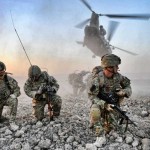 own people was gone. Those who would try to own slaves in the future would find that it was illegal. The Revolutionary War ended with the United States becoming a sovereign nation. Wars like World War I and II, were fought to end oppression, and of course, the War on Terrorism, to stop those who would try to control other nations and indeed, the world, through fear. I have to think that the War on Terrorism was one that had the greatest impact on the world.
own people was gone. Those who would try to own slaves in the future would find that it was illegal. The Revolutionary War ended with the United States becoming a sovereign nation. Wars like World War I and II, were fought to end oppression, and of course, the War on Terrorism, to stop those who would try to control other nations and indeed, the world, through fear. I have to think that the War on Terrorism was one that had the greatest impact on the world.
Since the beginning of the War on Terrorism, much has changed in the area of national security. Our airports are required to scrutinize travelers much more carefully than before. What used to take an hour, now takes as much as two or three. Metal detectors have been installed at all federal buildings. Screening have become normal…the new normal. We don’t like it, but we can’t change it either. Like it or not, it is for our safety. Terrorists don’t care who they hurt, their entire goal of bringing fear on the nations, is all they 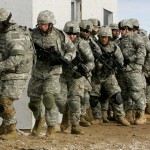 care about. Because of those people, we have had to change the way we look at…everyone!!
care about. Because of those people, we have had to change the way we look at…everyone!!
Now, we are in the middle of a new kind of war. It is a type of war on terrorism, but the targets of the attacks are very different. They aren’t going after any particular type of building, a particular size of building, or even a particular country. Nevertheless, their motive is to bring fear and terror to everyone they come in contact with. They are after complete submission. Like it or not, these are wars that had to or have to be won. If they are not, many lives will be lost, and unfortunately many things have to change to win this war.
 The year was 1959, and things were changing rapidly in the world of flight. Airplanes had been around, and actually flying since the December 17, 1903 flight of the Kitty Hawk by the Wright brothers. Air travel, while not as common as it is today, was fairly common. Now, it was time for the next step. We had looked through telescopes, found the planets, their moons, and other suns. We discovered galaxies beyond our own, and then, someone…somewhere, decided that it was time for mankind to go out there and have a look for ourselves.
The year was 1959, and things were changing rapidly in the world of flight. Airplanes had been around, and actually flying since the December 17, 1903 flight of the Kitty Hawk by the Wright brothers. Air travel, while not as common as it is today, was fairly common. Now, it was time for the next step. We had looked through telescopes, found the planets, their moons, and other suns. We discovered galaxies beyond our own, and then, someone…somewhere, decided that it was time for mankind to go out there and have a look for ourselves.
By late 1958 plans were well underway to take that first step. Seven men were picked, and on this day April 9, 1959 NASA announced that they had decided on the first seven astronauts, who would take that very first space flight. The men were dubbed The Mercury Seven, but were also called the Original Seven or Astronaut Group 1. The men were Scott Carpenter, Gordon Cooper, John Glenn, Gus Grissom, Wally Schirra, Alan Shepard, and Deke Slayton. They piloted the manned spaceflights of the Mercury program from May 1961 to May 1963. They weren’t the first men in space, but they were the first from the United States. The first human to journey into outer space, was Yuri Gagarin, when his Vostok spacecraft completed an orbit of the Earth on 12 April 1961. Alan Shepard became the first American in space  when the Freedom 7 spacecraft blasted off from Florida on May 5, 1961, just under a month after the Russian flight. Ten years later, Shepard would fly again to become the fifth man to walk on the moon…and the first to play golf there.
when the Freedom 7 spacecraft blasted off from Florida on May 5, 1961, just under a month after the Russian flight. Ten years later, Shepard would fly again to become the fifth man to walk on the moon…and the first to play golf there.
Most of these seven men went on to fly in many successful missions, with Gus Grissom being the only one to die young and on duty with NASA, in the Apollo 1 fire. Members of the group flew on all classes of NASA manned orbital spacecraft of the 20th century…Mercury, Gemini, Apollo, and the Space Shuttle. John Glenn, the oldest, is the only one who is still living. He went on to become a United States senator, and flew on the Shuttle 36 years later to become the oldest person to fly in space. The others all survived past retirement from service. These men played a key part in the world as we know it today, because space travel has played a key part in many of our modern medicines and scientific research. And it all began on this day in 1959.
 As I walked in to my bedroom today, my gaze landed on a bottle of perfume that sits on a shelf there. The bottle then took me back to my childhood years, because it always reminds me of the loving things my dad did for my mom. Evening In Paris Perfume by Bourjois, was a beautiful floral fragrance created by Ernest Beaux in 1928. It was reformulated by perfumers Jaques Polge and Francois Demachier, nearly fifty years later. The top notes are bergamot, apricot and peach, green notes and violet. The floral heart is composed of rose damascena, jasmine, heliotrope, ylang-ylang, lily of the valley, and orris. The base includes amber, musk, sandalwood, and vanilla. I have no idea how they managed to put all those ingredients together to come up with such a beautiful perfume, but they did. My mother, Collene Byer Spencer loved it, and my dad, Allen Spencer loved how it smelled on her. Dad would buy Evening in Paris for her on occasions like birthday, Christmas, and anniversaries. It was considered one of the most precious gifts he could give her.
As I walked in to my bedroom today, my gaze landed on a bottle of perfume that sits on a shelf there. The bottle then took me back to my childhood years, because it always reminds me of the loving things my dad did for my mom. Evening In Paris Perfume by Bourjois, was a beautiful floral fragrance created by Ernest Beaux in 1928. It was reformulated by perfumers Jaques Polge and Francois Demachier, nearly fifty years later. The top notes are bergamot, apricot and peach, green notes and violet. The floral heart is composed of rose damascena, jasmine, heliotrope, ylang-ylang, lily of the valley, and orris. The base includes amber, musk, sandalwood, and vanilla. I have no idea how they managed to put all those ingredients together to come up with such a beautiful perfume, but they did. My mother, Collene Byer Spencer loved it, and my dad, Allen Spencer loved how it smelled on her. Dad would buy Evening in Paris for her on occasions like birthday, Christmas, and anniversaries. It was considered one of the most precious gifts he could give her.
After Mom’s passing on February 22, 2015, as my sisters and I were going through her things, we came across several bottles of the perfume, some were empty, others has a little bit in them, but we each were able to have one of those bottles. It didn’t matter if we wore that perfume or not, we knew that just having the bottle would remind us of our parents, and of the deep love they had for each other. That perfume had such sentimental value, and in fact, I don’t believe that any of us ever took any without permission. Some things are too precious to touch, and even kids understand that. They create a respect of their own, and are given a place of honor in the home and in your heart. That was the case with Evening in Paris perfume. Little girls love to get into their mother’s makeup and perfume, but I really think we understood that Evening in Paris was off limits…and not because we were afraid of the trouble we would get in. It’s like you are in awe of it or something.
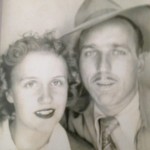
To this day, seeing that bottle of precious Evening in Paris perfume, makes me smile, because of the way my parents looked at each other when the package was opened. Mom always looked at Dad, just a little teary eyed, but with a great big smile on her face, and Dad looked like a little boy who had just brought his girlfriend her first rose. There was such a sense of pride that she loved the gift. He just felt good about it. He knew it was a special thing for her, and he hoped it was a surprise. She always acted like it was, whether she suspected it was coming or not. That was just their way. Theirs was a love without end, and they loved blessing each other with the best things they could give them, with the leader always being their love.

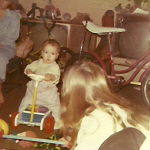 Time changes everything. Forty five years ago today, my sister, Cheryl Masterson became a mother, making my parents, Allen and Collene Spencer grandparents, and my sisters and me, aunts. It was such an exciting event for all of us, and it changed our lives forever. Never again would Cheryl be just a woman, she would be a mother from that day forward, as our parents would always be grandparents, and my sisters and I would always be aunts. At that time, the thought of that little baby growing up never crossed our minds, but my niece, Chantel Masterson Balcerzak had other ideas in mind…but then don’t all children. If they would just listen to us…they would stay babies forever
Time changes everything. Forty five years ago today, my sister, Cheryl Masterson became a mother, making my parents, Allen and Collene Spencer grandparents, and my sisters and me, aunts. It was such an exciting event for all of us, and it changed our lives forever. Never again would Cheryl be just a woman, she would be a mother from that day forward, as our parents would always be grandparents, and my sisters and I would always be aunts. At that time, the thought of that little baby growing up never crossed our minds, but my niece, Chantel Masterson Balcerzak had other ideas in mind…but then don’t all children. If they would just listen to us…they would stay babies forever
Not only was Chantel the first of the grandchildren for my parents, but she was quite little…not premature, just little. As with all grandparents, it seems like the cute little nicknames come out of the woodwork. Our family was no exception. What started out as little teeny baby, soon became Teensy, Little Teense, Chantsy, Chant, and even Chan. It’s a good thing that somebody, somewhere called her by her name, because otherwise, she might have thought her name was Teensy. And believe me when I say that Chantel grew into her nickname…or in her case, didn’t grow so she could fit her nickname. Chantel as an adult is all of four feet ten inches short. So, I can’t say that she grew up exactly, she simply became an adult, and I don’t think we were expecting that to happen so quickly. Nevertheless, before we knew it, Chantel was grown up, and my sister, Cheryl became a grandmother, our parents became great grandparents, and my sisters and I became great aunts. It seemed impossible that it could have happened so soon.
As we all know, time changes everything, and now, my niece Chantel has become a grandmother to Izabella Harman, Cheryl is the great grandmother, and my sisters and I are 2nd great aunts. Where have the years gone? And they aren’t slowing down either. Little Izabella is already more than 3 months old. Of course, she isn’t always called Izabella, because her grandma, Chantel likes to call her Belle or Bella. And she sings all the 
 cute little songs to her…adding her name to it. Chantel loves being Belle’s grandma, and Belle loves her too. Of course, Chantel’s own nicknames haven’t gone away. Sometimes, I can still hear my dad calling her Teensy. Now that I think about it, I’m sure that he would calling her Grandma Teensy instead, because after all, time has changed that too, and now she can’t simply be Teensy…not when she is grandma to Belle. My dad would have loved that and he would have loved calling her Grandma Teensy too. Today is Chantel’s birthday. Happy birthday Chantel!! Have a great day!! We love you!!
cute little songs to her…adding her name to it. Chantel loves being Belle’s grandma, and Belle loves her too. Of course, Chantel’s own nicknames haven’t gone away. Sometimes, I can still hear my dad calling her Teensy. Now that I think about it, I’m sure that he would calling her Grandma Teensy instead, because after all, time has changed that too, and now she can’t simply be Teensy…not when she is grandma to Belle. My dad would have loved that and he would have loved calling her Grandma Teensy too. Today is Chantel’s birthday. Happy birthday Chantel!! Have a great day!! We love you!!
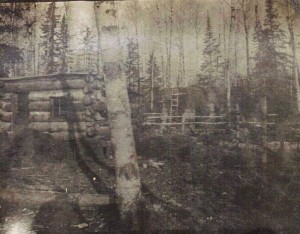 For a time, my grandfather, Allen Luther Spencer, worked in the lumber business. It started when he and my grandmother’s brother, Albert Schumacher, decided to go trapping in northern Minnesota. That venture didn’t go very well, and they just about froze to death. It was at that time that they decided to go into the lumber business. Being a lumberjack is no easy job, and was probably much more dangerous in my grandfather’s day, than it is now. Back then, lumberjacks, as they were called did everything from chopping down the trees, to cutting them with a saw, climbing up in the tree to get to the top. You name it, if it pertained to logging, they did it. They called it harvesting, and it begins with the lumberjack. The term lumberjack is not a term that is used much
For a time, my grandfather, Allen Luther Spencer, worked in the lumber business. It started when he and my grandmother’s brother, Albert Schumacher, decided to go trapping in northern Minnesota. That venture didn’t go very well, and they just about froze to death. It was at that time that they decided to go into the lumber business. Being a lumberjack is no easy job, and was probably much more dangerous in my grandfather’s day, than it is now. Back then, lumberjacks, as they were called did everything from chopping down the trees, to cutting them with a saw, climbing up in the tree to get to the top. You name it, if it pertained to logging, they did it. They called it harvesting, and it begins with the lumberjack. The term lumberjack is not a term that is used much 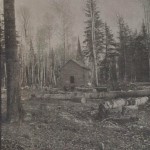 these days, because the modern way of harvesting is very different. Lumberjacks were pretty much a pre-1945 term. Hand tools were the harvest tools used, because there were no machines like what we have now.
these days, because the modern way of harvesting is very different. Lumberjacks were pretty much a pre-1945 term. Hand tools were the harvest tools used, because there were no machines like what we have now.
The actual work of a lumberjack was difficult, dangerous, intermittent, low-paying, and primitive in living conditions, but the men built a traditional culture that celebrated strength, masculinity, confrontation with danger, and resistance to modernization. These days, there are a few people who actually celebrate the lumberjacking trade. Mostly it involves competitions, but just by watching, you can see that being a lumberjack was not a job for a weakling.
Lumberjacks, and their families, usually lived in a lumber camp, moving from site to site and the job moved. I 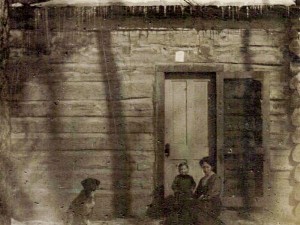 know that my grandmother and my Aunt Laura spent time in the lumber camps. From what I’ve been told, the houses were little more that a log tent. They didn’t stay very warm, because there were gaps in the walls, and my guess is that they could only use a certain amount of wood a day, so it didn’t eat into the profits. I suppose that the owner of the logging operation made a good profit, but that doesn’t mean that the people who worked for them made a great deal of money, because they really didn’t. Being a lumberjack was really a far from glamorous occupation, and like most really physical jobs, not one that a man can do for too many years. Before long, my grandfather, like most lumberjacks, moved on to other jobs, in grandpa’s case the railroad.
know that my grandmother and my Aunt Laura spent time in the lumber camps. From what I’ve been told, the houses were little more that a log tent. They didn’t stay very warm, because there were gaps in the walls, and my guess is that they could only use a certain amount of wood a day, so it didn’t eat into the profits. I suppose that the owner of the logging operation made a good profit, but that doesn’t mean that the people who worked for them made a great deal of money, because they really didn’t. Being a lumberjack was really a far from glamorous occupation, and like most really physical jobs, not one that a man can do for too many years. Before long, my grandfather, like most lumberjacks, moved on to other jobs, in grandpa’s case the railroad.
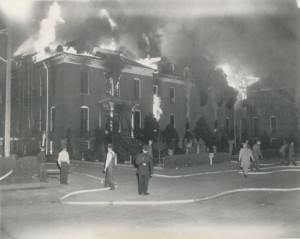 Much has been learned over the years about fire safety and about the things that can be extremely hazardous. Unfortunately, as with most things humans learn about, this information came at a price. Just before midnight on April 4, 1949, in Effingham, Illinois, at Saint Anthony’s Hospital, a fire broke out. I can’t imagine a worse place to have a fire, than a hospital or nursing home, because not everyone can just stand up and file out of the building in a safe and orderly fashion. In addition to that, there were not as many fire safety regulations in place back then. The resulting disaster caused the death of 74 people at the hospital.
Much has been learned over the years about fire safety and about the things that can be extremely hazardous. Unfortunately, as with most things humans learn about, this information came at a price. Just before midnight on April 4, 1949, in Effingham, Illinois, at Saint Anthony’s Hospital, a fire broke out. I can’t imagine a worse place to have a fire, than a hospital or nursing home, because not everyone can just stand up and file out of the building in a safe and orderly fashion. In addition to that, there were not as many fire safety regulations in place back then. The resulting disaster caused the death of 74 people at the hospital.
This fire became the example of the special hazards that hospitals can present for a fire disaster, and it was that reason for the regulations to be updated. The safety of the patients was paramount, and something had to  be done. The hospital was operated by the Sisters of Saint Francis, who lived at the convent next door to the hospital. The was constructed mainly out of wood and brick. It housed 100 beds. Parts of the building dated back to 1876. By 1949 the facility was completely outdated. It contained open corridors and staircases. Many walls and ceilings were covered with oilcloth fabrics and combustible soundproof tiles. The building lacked sprinklers, as well as fire detection and alarm systems. Because the hospital was built of wood and brick, and much of it was an open floor plan, there was little to stop the progression of the fire. The combustible building materials gave no resistance to the advancement of the flames.
be done. The hospital was operated by the Sisters of Saint Francis, who lived at the convent next door to the hospital. The was constructed mainly out of wood and brick. It housed 100 beds. Parts of the building dated back to 1876. By 1949 the facility was completely outdated. It contained open corridors and staircases. Many walls and ceilings were covered with oilcloth fabrics and combustible soundproof tiles. The building lacked sprinklers, as well as fire detection and alarm systems. Because the hospital was built of wood and brick, and much of it was an open floor plan, there was little to stop the progression of the fire. The combustible building materials gave no resistance to the advancement of the flames.
At the time of the fire, there were 116 patients and ten staff members were on duty. Many of them were trapped on the upper floors when the fire engulfed the lower floors. This number included eleven newborn infants and the nurse who stayed behind with them. A total of 74 people died, including patients, nurses, nuns, a priest and Frank Ries, the hospital superintendent who ran into the flames to try to rescue his wife. The Effingham Volunteer Fire Department, with its 26 men and three pumpers were fighting a losing battle. They simply didn’t have the resources they needed to put out a fire of this magnitude. Eleven other fire departments 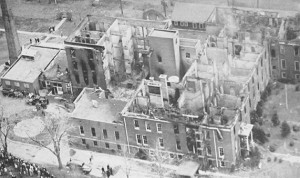 also responded. but little could be done.
also responded. but little could be done.
The cause was never determined, but investigators found many safety issues with the building. Something had to change. In response to the fire, Governor Adlai Stevenson ordered the evaluation of all the hospitals in the state to identify and mitigate fire hazards. The impact of the fire went beyond Illinois as hospitals across the United States made many of the fire protection improvements that are standard today. It is sometimes a matter of live and learn in this life, but it is very sad that it takes something as tragic as this to look into the possible fire hazards that can quickly end a life.
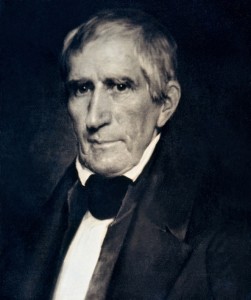 When we think of the president of the United States…in general terms, we often wonder if he will be good enough to be re-elected and serve the maximum term of eight years. We seldom think about whether or not he will finish his first year…or even month for that matter. And few of us can name the president with the sad title of being the president of the United States for the shortest term. Nevertheless, that is a record that has to be held by someone, and that man was William Henry Harrison, who was our 9th President. Harrison’s inaugural speech, delivered on a bitterly cold March morning, lasted one hour and forty five minutes. Harrison wasn’t really feeling well at the time, and went to bed at the end of inauguration day with a bad cold. The cold quickly developed into what would become a fatal case of pneumonia. I have to wonder if he would have been just fine in this day and age of modern medicine. Not everyone gets pneumonia these days, but most of those who do, survive and go on to lead long lives. Pneumonia isn’t the death sentence these days that it used to be.
When we think of the president of the United States…in general terms, we often wonder if he will be good enough to be re-elected and serve the maximum term of eight years. We seldom think about whether or not he will finish his first year…or even month for that matter. And few of us can name the president with the sad title of being the president of the United States for the shortest term. Nevertheless, that is a record that has to be held by someone, and that man was William Henry Harrison, who was our 9th President. Harrison’s inaugural speech, delivered on a bitterly cold March morning, lasted one hour and forty five minutes. Harrison wasn’t really feeling well at the time, and went to bed at the end of inauguration day with a bad cold. The cold quickly developed into what would become a fatal case of pneumonia. I have to wonder if he would have been just fine in this day and age of modern medicine. Not everyone gets pneumonia these days, but most of those who do, survive and go on to lead long lives. Pneumonia isn’t the death sentence these days that it used to be.
William Harrison was the last president born as an English subject before the American Revolution. After that time, it became law that the president must be a natural born citizen, something that has sparked bitter battles in these modern times. He hailed from Virginia, and attended college intending to become a doctor, but opted to join the army before finishing his degree. President John Adams took note of Harrison’s exemplary service in the Indian Wars of the Northwest Territories. In 1801, President Adams appointed him governor of the Northwest Territories, which is now Indiana and Illinois. Harrison later fought in the Battle of the Thames River during the War of 1812. After that time, he decided to go into politics, and went on to become a congressman and the ambassador to Colombia before running with John Tyler on the Whig Party ticket in the presidential election of 1840, which he won, but this would not prove to be a long term in office for him. In fact, his death came exactly one month after he was inaugerated into office.
I have to wonder what things he might have done differently than his running mate, John Tyler did. Harrison was 68 years and 23 days old when he took office. He was the oldest president to take office until Ronald 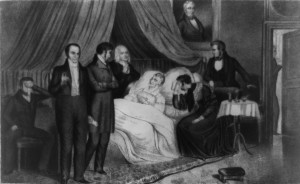 Reagan in 1981. After his passing, there was a brief constitutional crisis, because this had never happened before, and it had to be decided, who would take over. The solution was not widely accepted, and there were disputes as to the presidential line of succession, with regard to the Constitution up until the passage of the 25th Amendment in 1967. William Henry Harrison was the grandfather of Benjamin Harrison, who was the 23rd President from 1889 to 1893, so his line did have a second chance at the course that the country would take, even though he was not directly involved. Of course, there is nothing to indicate that Benjamin would have had the same values as William did. Things change over the years, but he was a Republican…a good thing in my opinion.
Reagan in 1981. After his passing, there was a brief constitutional crisis, because this had never happened before, and it had to be decided, who would take over. The solution was not widely accepted, and there were disputes as to the presidential line of succession, with regard to the Constitution up until the passage of the 25th Amendment in 1967. William Henry Harrison was the grandfather of Benjamin Harrison, who was the 23rd President from 1889 to 1893, so his line did have a second chance at the course that the country would take, even though he was not directly involved. Of course, there is nothing to indicate that Benjamin would have had the same values as William did. Things change over the years, but he was a Republican…a good thing in my opinion.
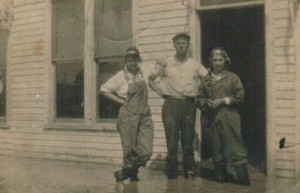 After my husband, Bob’s 2nd great grandma, Mary LuLu Taylor remarried, following the death of her first husband, James Leary, on March 26, 1888, she and her second husband had three children, bringing to four the total number of her children. Her life had taken her from Forsyth, Montana to Shelby, Missouri, where she met James Begier, who became her second husband. Later, they would move to several other times, but Montana always seemed to be in her blood and she would return there several times. Her daughter Mabel Claire Begier met and married her husband, Edward Anthony Brown in Rosebud, Montana. I’m not positive at what point Mabel became a telephone operator, but she did, and as it turns out, that’s where she was working during one of the floods that took place in Montana. That job, at that time in history, put her right in the middle of a serious situation, and in a position to help those in need of assistance.
After my husband, Bob’s 2nd great grandma, Mary LuLu Taylor remarried, following the death of her first husband, James Leary, on March 26, 1888, she and her second husband had three children, bringing to four the total number of her children. Her life had taken her from Forsyth, Montana to Shelby, Missouri, where she met James Begier, who became her second husband. Later, they would move to several other times, but Montana always seemed to be in her blood and she would return there several times. Her daughter Mabel Claire Begier met and married her husband, Edward Anthony Brown in Rosebud, Montana. I’m not positive at what point Mabel became a telephone operator, but she did, and as it turns out, that’s where she was working during one of the floods that took place in Montana. That job, at that time in history, put her right in the middle of a serious situation, and in a position to help those in need of assistance.
When we think of any disaster…be it fire, earthquake, tornado, or flood, our first instinct these days is to dial 911 on our phones. That has become the go to number for all kinds of help in times of need. That wasn’t always the case though. Years ago, it was the operator you called for help. You simply dialed “0” to get in touch with someone who could connect you with any branch of emergency help there was…as well as to let everyone else in town know about the emergency…at least back then they could. Privacy laws would have prevented that these days. Of course, if it was a big emergency, letting everyone know would be her job.
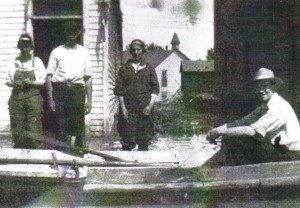 Mabel Begier was an operator during an emergency that would have qualified as one in which it was acceptable to let people know, but then my guess is that most people already knew that it was coming. Floods in towns where you live near a river are common in the Spring, especially after a particularly high snowfall year. People who live near rivers already know that Spring means that you have to watch the water levels, stay prepared to evacuate, and stay informed at all times. At that time in history, when a warning needed to be sent out, you called the operator to get the warning out. That was where Mabel came in, and she loved her job. I think the job that she had was very important, and she was a key part of the emergency efforts of that era.
Mabel Begier was an operator during an emergency that would have qualified as one in which it was acceptable to let people know, but then my guess is that most people already knew that it was coming. Floods in towns where you live near a river are common in the Spring, especially after a particularly high snowfall year. People who live near rivers already know that Spring means that you have to watch the water levels, stay prepared to evacuate, and stay informed at all times. At that time in history, when a warning needed to be sent out, you called the operator to get the warning out. That was where Mabel came in, and she loved her job. I think the job that she had was very important, and she was a key part of the emergency efforts of that era.
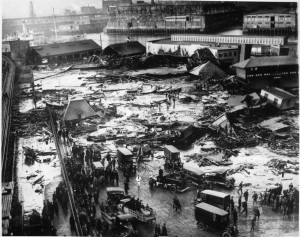 These days, most tsunami waves come with prior warning…at least since the 1946 wave that hit Alaska and Hawaii. Nevertheless, there are disastrous waves that are largely unpredictable, and those can be as deadly as the ones that the Pacific Tsunami Warning System warns people about. One in particular I had never heard of, until my sister Cheryl Masterson heard about it and mentioned it a few days ago. It happened in Boston, Massachusetts on January 15, 1919, and while it was of a very different variety than most tsunamis, it was deadly nevertheless. This tsunami was so strange, in fact, that most people wouldn’t even believe that this is a true story, but it did happen.
These days, most tsunami waves come with prior warning…at least since the 1946 wave that hit Alaska and Hawaii. Nevertheless, there are disastrous waves that are largely unpredictable, and those can be as deadly as the ones that the Pacific Tsunami Warning System warns people about. One in particular I had never heard of, until my sister Cheryl Masterson heard about it and mentioned it a few days ago. It happened in Boston, Massachusetts on January 15, 1919, and while it was of a very different variety than most tsunamis, it was deadly nevertheless. This tsunami was so strange, in fact, that most people wouldn’t even believe that this is a true story, but it did happen.
Around 12:40pm on January 15, 1919, a storage tank holding 2.3 million gallons of molasses exploded at the Purity Distilling Co. in the North End of Boston, sending waves of molasses rushing through the streets at almost 35 miles per hour. I’m sure that many people wouldn’t even think of this event as being at all dangerous, I mean after all, it’s just molasses. Nevertheless, a 25 foot high wave of molasses coming at you going 35 miles per hour is as deadly as being hit be a car. There was no warning, and in reality, there couldn’t  be. The molasses was being stored in the tank awaiting transfer to another plant and, due to its quickly rising temperature, it set off a tragic and previously unheard of chain of events. According to witnesses, the ground shook as if a tornado or freight train were coming down the street.
be. The molasses was being stored in the tank awaiting transfer to another plant and, due to its quickly rising temperature, it set off a tragic and previously unheard of chain of events. According to witnesses, the ground shook as if a tornado or freight train were coming down the street.
According to The Boston Globe, citizens “were picked up by a rush of air and hurled many feet.” A truck itself was picked up by the gushing wave and thrown into Boston Harbor. The force of the wave was so destructive, it almost tipped a railroad car off of Boston’s elevated railway tracks.” And The Boston Post described the gruesome scene, “Molasses, waist deep, covered the street and swirled and bubbled about the wreckage. Here and there struggled a form — whether it was animal or human being was impossible to tell. Horses died like so many flies on sticky fly-paper. The more they struggled, the deeper in the mess they were ensnared. Human beings — men and women — suffered likewise.”
The final death toll was set at 21, while 150 people were injured. The dead were either crushed by debris filled molasses, or drowned by the molasses itself. People and animals were seen struggling, some for which nothing could be done. The clean up was massive. Fire trucks were brought in to hose down the streets, and welders to 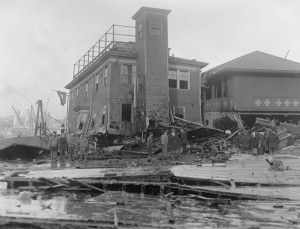 cut the tank up. The harbor was brown until summer. The molasses seeped into every crack, and it is said that on hot summer days, you could smell it for decades. I’m not sure how that could be, but maybe their minds played tricks in them too. In the end, the public outcry made a lawsuit necessary. The townspeople brought a class-action suit against the United States Industrial Alcohol Company, which had recently bought the Purity Distilling Company. Three years of hearings later, the USIAC was found guilty and forced to pay $600,000, which would equate to almost $10 million today, in settlements for negligence. The wave was as deadly as any tsunami could have been, but in reality, no warning could have prevented this tragedy.
cut the tank up. The harbor was brown until summer. The molasses seeped into every crack, and it is said that on hot summer days, you could smell it for decades. I’m not sure how that could be, but maybe their minds played tricks in them too. In the end, the public outcry made a lawsuit necessary. The townspeople brought a class-action suit against the United States Industrial Alcohol Company, which had recently bought the Purity Distilling Company. Three years of hearings later, the USIAC was found guilty and forced to pay $600,000, which would equate to almost $10 million today, in settlements for negligence. The wave was as deadly as any tsunami could have been, but in reality, no warning could have prevented this tragedy.

